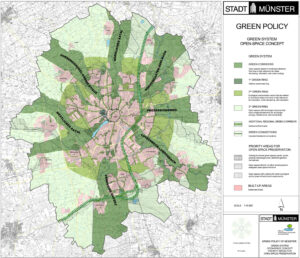
Can peripheral green areas be a technical solution to problems of pollution and urban dispersion, or for providing communities access to nature areas? They sure can. When properly planned, green belts also help reduce noise, conserve biodiversity, and even encourage people to walk more.
What is an urban green belt?
Urban green belts are areas of vegetation surrounding cities that aim to improve the environmental quality and well-being of residents. These natural spaces offer multiple benefits for cities from ecological, social, and economic points of view.
The most well-known green belt is the Greater London Belt of England, which surrounds the city of London almost entirely. There’s also the Green Belt of Burgos (Spain) and the Metropolitan Green Belt of Medellín (Colombia). Within mitigation and adaptation strategies to the climate crisis, more and more cities are surrounding their urban areas with a green mantle.
Green filters: the green wave against pollution
Urban environments, due to their density and sometimes due to their size, tend to accumulate chemical environmental pollution, a form of pollution that negatively affects the health of their residents. What if we used vegetation as an anti-pollution filter?
In 2022, a Barcelona resident got on his bike with a CO2 meter and pedaled around for hours. The result? First-hand citizen science and an empirical demonstration that pollution dropped drastically near green areas: “The CO2 measurements showed a reduction in the areas where GPS indicated forests, parks, and agricultural areas.”
During photosynthesis, plants take CO2 out of the environment, storing its carbon. But they don’t just clean up this molecule. In 1989, NASA did an experiment that showed that some plants also removed volatile organic compounds. Vegetation is a city’s filter, though there are limits: it is estimated that the vegetation only removes between 1% and 15% of chemical contamination. Still, it’s something.
Green crowns to fight territorial dispersion
Preventing territorial dispersion is one of those ecological tasks many cities on the planet still have to take on. Dispersed cities have a greater impact per capita than those that are more compact. They consume less fuel, energy, and resources, partly due to shared infrastructure: when your roof is the neighbor’s floor, the embodied energy of the materials is divided by two; when neighbors live close together, sewers are shorter, etc.
Is there infrastructure capable of containing the city and making it more efficient? “The development of green belts on the periphery of urban centers could contribute to limiting the increase of urban areas in a given region, reducing damage to the environment,” says a recent study that analyzed 60 European cities over nine years (2006-2015).
As the authors point out, “90% of cities that have a green belt have seen a decrease in urban expansion during the period in question,” compared to 36.7% of cities without a belt that also reduced their expansion. However, the authors point out that “their effectiveness may be impaired if they are not properly protected or if they are too small or narrow.”
When we asked Jochen Jaeger, one of the authors of the study, how wide the circular crown that makes up the perimeter forest should be, he replied by email that “there is no universal radius [but] that it depends on the size of the city and the environment.” Each city has its own peculiarities, though urban belts tend to densify the city.
Trees for micro-climate control
Trees provide shade, preventing the Sun’s radiation from reaching pavement. That alone significantly reduces surface temperature. In addition, vegetation sweats water through a mechanism called evapotranspiration, and that sweat refreshes the atmosphere. According to some estimates, the tree mass can bring down temperatures from 8°C to 12°C in Central Europe, and up to 4°C in southern Europe, generally speaking; however, more drastic examples have been found, like the shade cooling 8°C to 16°C with highs of 19°C in Italy. In the picture, Münster (Germany) and its green belt.

Map of the “Green Politics of Münster” (“Grünordnung Münster”). (Source: Stadt Münster, n.d.). Stadt Münster. (n.d.). Stadt Münster: Amt für Grünflächen, Umwelt und Nachhaltigkeit – Umwelt- und Freiraumplanung – Grünordnung Münster. Retrieved May 27, 2022, from
https://www.stadt-muenster.de/umwelt/umwelt-und-freiraumplanung/gruenordnung-muenster#c24934
But the trees don’t even have to be close together to cool the environment. Urban green belts, and in general all green infrastructure, are known help to mitigate the heat island effect. It is estimated that reducing the temperature of the entire city by one degree is possible by covering 16% of the surface with shade (green belts), to reference one of the thousands of scientific studies on this subject.
“Green and blue urban infrastructures, such as urban forests and urban woodland, permeable surfaces, and green roofs, offer the possibility of mitigating climate change directly by storing carbon, and indirectly by inducing a cooling effect that reduces energy demand,” says the IPCC’s Sixth Assessment Report (2022).
More quiet areas for residents to enjoy
Perhaps more tangibly for residents’ day-to-day life, a particular strength of peripheral urban forests is bringing the forest closer to the city so that in a very short time (in some cases, minutes) neighbors can find themselves in the middle of a green area that is not a park. This way, families don’t have to travel far to spend the day in the countryside: it’s right next to the city.
Green infrastructure has demonstrated its “ecological, economic, and social benefits through natural solutions,” says the European Environment Agency. The social benefits include reducing stress and preventing mental illness. Cities undoubtedly need to invest in green infrastructure as an urban solution.






There are no comments yet